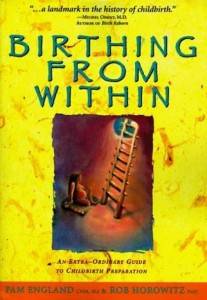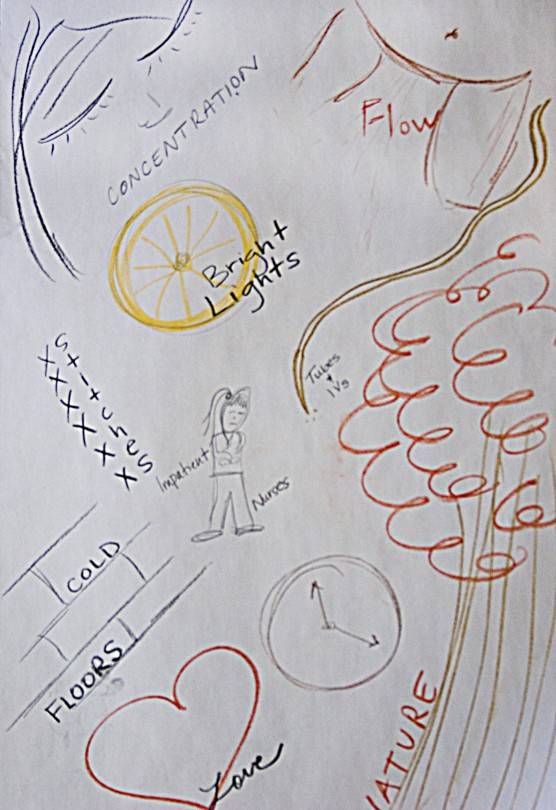 I was first introduced to Pam England and Rob Horowitz’s Birthing from Within by local doula Sue Osborne. Being a few short weeks away from my own labor, I am naturally curious about birthing philosophies, and especially interested in anything that might offer pain-coping strategies. I wanted a unbiased book that would educate me about possible hospital interventions (and how to avoid them).
I was first introduced to Pam England and Rob Horowitz’s Birthing from Within by local doula Sue Osborne. Being a few short weeks away from my own labor, I am naturally curious about birthing philosophies, and especially interested in anything that might offer pain-coping strategies. I wanted a unbiased book that would educate me about possible hospital interventions (and how to avoid them).
Until this pregnancy, I was completely unaware that home birth is illegal in the state of Illinois. I did not even realize it was the kind of thing that could be illegal. I would not have chosen a home birth, but being told that I absolutely cannot have one, especially when there is no evidence to back up such a law (such as a higher mortality rate for home births), just really gets under my skin. But that’s another article…
So here in Champaign, there are two options for giving birth: Provena or Carle. There is currently no birth center in Champaign county. And I, like many women I have spoken to, am very uncomfortable, or at the very least, out of my element, in a hospital. Hospitals are cold; there are machines that remind me of death and illness; there are people walking around in weird outfits and bad shoes; and there is nothing about the building that I would equate to natural. Hospitals and birthing are at odds, at least to my sensitivities. But there are techniques ― ways of tricking our brains ― to help us relax and birth naturally in a hospital. Birthing from Within, though it has many references to home birth, can help women and partners prepare for birth (both natural and intervention) in a hospital.
England bases the book on her birthing classes and what she has learned as a birth coach from her students. One of my favorite things about this book is the many anecdotal stories within, one of the many ways England connects women and partners to people around the world.
The first section of the book is titled “Beginning Your Journey,” which includes subheadings such as “Finding Your Question,” “Emptying Your Mind,” and “Worry is the Work of Pregnancy.” I was especially intrigued by the idea of “Finding Your Question.” England says that knowing your question, which will be different for every woman, is central to birth preparation. So what is my question? I had to do some real soul-searching for this exercise. I made a list, which ended up being a long line of distractions from the question I really was asking, which I wrote on the final line: Can I handle the pain?
The exercise was very freeing. Just writing it down ― acknowledging my fears ― allowed me to address them. In the section on worry, England lists the top ten worries of pregnant women, and the first one is: Not being able to stand the pain. She goes on to say that worry is the work of pregnancy. She presents worry, not as something to avoid and overcome, but as a necessary part of preparation. Phew, I thought, now tell me more.
Section two of the book describes how art, or the creative process, can help you find your birth question. I’ll admit that I found this section completely absurd, granola, and ― at best ― silly. But for the sake of this article I decided to give it a try. One of the exercises is this: When you think about being in labor, what image comes to mind? How does it feel for you to be giving birth?
It wasn’t nearly as silly as I thought it would be. In fact, it was very telling, considering I placed an impatient nurse right smack in the middle. I hate that nurse.

So these are the things I need to address, now, as I prepare for birth.
The book goes on to talk about things like “Childbirth as a Right of Passage,” “The Birth Plan Trap,” and “Labor Means Hard Work.” What I found especially encouraging, and unique about this book, is the author’s acceptance of all kinds of birth. One of the sections is titled “How to Give Birth if You Need a Cesarean.” I found this section incredibly thoughtful and moving. No matter what type of birth we have, or have had, it is important to fully embrace it and to discourage the idea that something went wrong or that the mother failed. There is something to learn from every birth and even a cesarean birth can be a spiritual, emotional, and loving process.
The next section is titled “Fathers and Birth Companions,” which I would encourage any birth partner to read. Now if I could only get my own husband to read it…
Personally, the grand prize in this book is section six: “Birthing Through Pain.” This chapter not only gives training exercises for dealing with pain (holding an ice cube in your hand for 60 seconds is surprisingly uncomfortable), but also offers visualizations, scientific research concerning the usefulness of pain, and how pain avoidance disrupts the natural process of birth.
What I took away from this book is a reminder that I’m not alone and that I can “birth from within,” even if I get the cranky nurse I so fear. And in that way I’m connected to all the women in the world who have ever given birth, are now giving birth, or might ever give birth. I think that’s what England means when she says, “Birth is a universal experience…How can there be just one right way to give birth when there are billions of women in this world?”








